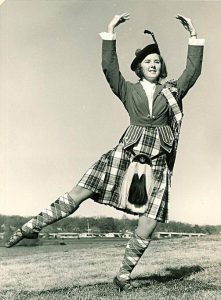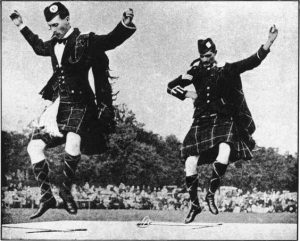
Highland Dancing is a celebration of the Scottish spirit ~ a spectacular combination of strength, agility, movement, music, and costume.
Unlike other dance mediums, Highland dances are generally danced solo and in competition. Dancers typically dance to traditional Scottish music such as Strathspeys, Reels, Hornpipes and Jigs all played by an accompanying bagpiper. The dances are made up of different parts, called steps and there are usually four or six steps to a dance. The dances are great fun and anyone, not just those with a Scottish heritage, who thrills to the sound of the bagpipe can join in and learn the dances. Highland dancing was traditionally performed by men but is now performed by men and women. It is one of few arenas where men and women compete equally. In most competitions, the number of women competing far exceeds the number of men. Highland Dancing is a healthy workout for adults and for children. It is a great way to develop good coordination, posture and overall muscle tone, not to mention aerobic capacity and strength. One study showed that a half hour of dance was equal to a game of soccer. Ambitious new students develop self-discipline and confidence as they learn to tackle the physical demands of Highland dancing. Indeed, the tremendous strength, stamina, and technical precision that accomplished dancers exhibit on stage comes from years of independent training and collaboration with experienced teachers. In addition to perpetuating a great cultural tradition, highland dancers appreciate the athletic challenges, competitive goals, performance opportunities as well as the opportunity to meet and become lifelong friends with dancers from other areas, both nationally and internationally, that participation in this ethnic art form/sport affords them.
There are two styles of Highland Dances: the traditional Highland Dances and the graceful National Dances.
 Highland Dances
Highland Dances
Highland Fling
Likely the oldest of the traditional dances of Scotland, the Highland Fling signifies victory following a battle. The warriors made this dance a feat of strength and agility by dancing on their upturned shields which had a sharp spike of steel projecting from the center. Dancers learned early to move with great skill and dexterity. Others say the Highland Fling was inspired by the sight of a deer prancing on a hillside. The upraised arms and hands in the dance represent the deer’s antlers.
Sword Dance (Gillie Callum)
Legend has it that the initial Gillie Callum was created by Malcolm Canmore, a Celtic Prince who fought a battle in 1054. Triumphant, he crossed his opponent’s sword with his own and danced over them celebrating his victory. It is also said that the warriors danced the Sword Dance prior to battle. If the warrior touched the swords, it was considered an omen symbolizing injury or death in battle.
Seann Triubhas (Old Trousers)
This dance originated as a political protest dating back to 1745 when the wearing of the kilt was an act of treason. Pronounced “shawn trews”, this Gaelic phrase means “old trousers”. The beautiful, graceful steps reflect the restrictions imposed by the foreign trousers. The lively quick time in the dance recreates the Highlanders’ celebration of rediscovered freedom.
The Reels
The Reel O’Tulloch is said to have started in a churchyard on a cold winter morning when the minister was late for his service. The parishioners tried to keep warm by stamping their feet, clapping their hands and swinging each other by the arms.
 National Dances
National Dances
The National Dances are more modern than the Highland Dances and were developed so women could participate. The costume worn by women is called the Aboyne dress named in honor of the Aboyne Highland Games in Scotland where women were forbidden to wear the traditional Highland outfit. The National Dances are much more rhythmic and balletic; however, they still require quick and precise movements. Some of the dances are the Scottish Lilt, Village Maid, Blue Bonnets and Scotch Measure. Several National Dances are performed in the kilt since they were originally men’s dances such as The Highland Laddie, and Wilt Thou Go to the Barracks, Johnny? Men, of course, also perform all of the dances, but they wear the traditional Highland outfit.
Irish Jig
The Scottish version of the Irish Jig is meant to parody an angry Irish washerwoman when she finds out some neighborhood boys have knocked all of her clean wash to the ground. Another version describes a woman who shakes her firsts and flounces her skirt because she is furious with her husband who has been out drinking until the wee hours.
Sailor’s Hornpipe
The Sailor’s Hornpipe requires strength and stamina to mimic in dance a variety of shipboard tasks including swabbing the deck, climbing the ship’s rigging, standing watch and hauling in rope. The Hornpipe is danced in a British sailor’s uniform and derived its name from the fact that usually the musical accompaniment was played on a hornpipe rather than bagpipes.




















Leave a Comment